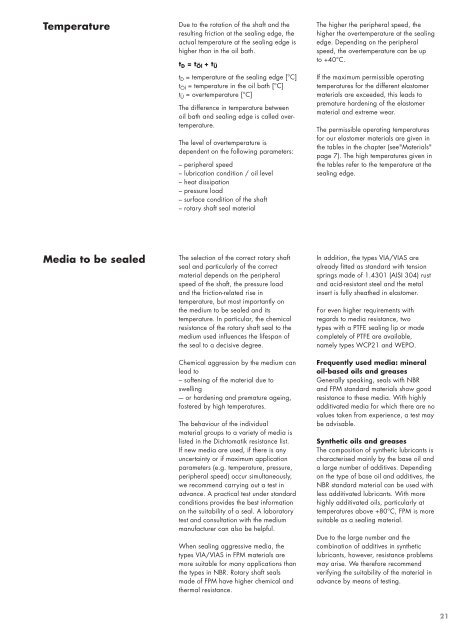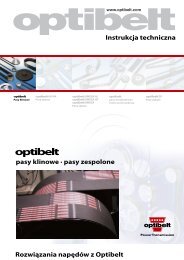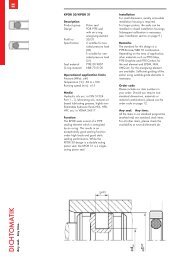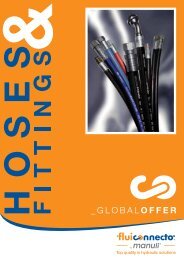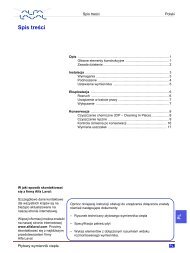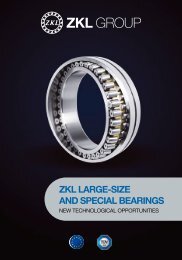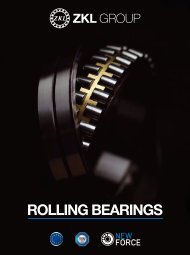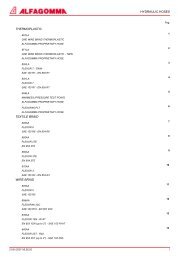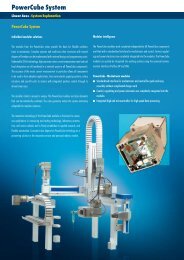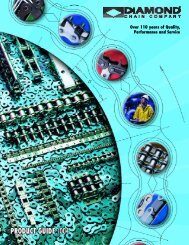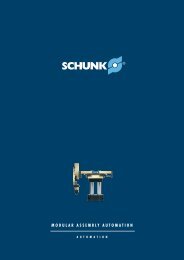DICHTOMATIK
DICHTOMATIK - Spinet
DICHTOMATIK - Spinet
- No tags were found...
Create successful ePaper yourself
Turn your PDF publications into a flip-book with our unique Google optimized e-Paper software.
Temperature<br />
Due to the rotation of the shaft and the<br />
resulting friction at the sealing edge, the<br />
actual temperature at the sealing edge is<br />
higher than in the oil bath.<br />
t D = t Öl + t Ü<br />
t D = temperature at the sealing edge [°C]<br />
t Öl = temperature in the oil bath [°C]<br />
t Ü = overtemperature [°C]<br />
The difference in temperature between<br />
oil bath and sealing edge is called overtemperature.<br />
The level of overtemperature is<br />
dependent on the following parameters:<br />
– peripheral speed<br />
– lubrication condition / oil level<br />
– heat dissipation<br />
– pressure load<br />
– surface condition of the shaft<br />
– rotary shaft seal material<br />
The higher the peripheral speed, the<br />
higher the overtemperature at the sealing<br />
edge. Depending on the peripheral<br />
speed, the overtemperature can be up<br />
to +40°C.<br />
If the maximum permissible operating<br />
temperatures for the different elastomer<br />
materials are exceeded, this leads to<br />
premature hardening of the elastomer<br />
material and extreme wear.<br />
The permissible operating temperatures<br />
for our elastomer materials are given in<br />
the tables in the chapter (see"Materials"<br />
page 7). The high temperatures given in<br />
the tables refer to the temperature at the<br />
sealing edge.<br />
Media to be sealed<br />
The selection of the correct rotary shaft<br />
seal and particularly of the correct<br />
material depends on the peripheral<br />
speed of the shaft, the pressure load<br />
and the friction-related rise in<br />
temperature, but most importantly on<br />
the medium to be sealed and its<br />
temperature. In particular, the chemical<br />
resistance of the rotary shaft seal to the<br />
medium used influences the lifespan of<br />
the seal to a decisive degree.<br />
Chemical aggression by the medium can<br />
lead to<br />
– softening of the material due to<br />
swelling<br />
-– or hardening and premature ageing,<br />
fostered by high temperatures.<br />
The behaviour of the individual<br />
material groups to a variety of media is<br />
listed in the Dichtomatik resistance list.<br />
If new media are used, if there is any<br />
uncertainty or if maximum application<br />
parameters (e.g. temperature, pressure,<br />
peripheral speed) occur simultaneously,<br />
we recommend carrying out a test in<br />
advance. A practical test under standard<br />
conditions provides the best information<br />
on the suitability of a seal. A laboratory<br />
test and consultation with the medium<br />
manufacturer can also be helpful.<br />
When sealing aggressive media, the<br />
types VIA/VIAS in FPM materials are<br />
more suitable for many applications than<br />
the types in NBR. Rotary shaft seals<br />
made of FPM have higher chemical and<br />
thermal resistance.<br />
In addition, the types VIA/VIAS are<br />
already fitted as standard with tension<br />
springs made of 1.4301 (AISI 304) rust<br />
and acid-resistant steel and the metal<br />
insert is fully sheathed in elastomer.<br />
For even higher requirements with<br />
regards to media resistance, two<br />
types with a PTFE sealing lip or made<br />
completely of PTFE are available,<br />
namely types WCP21 and WEPO.<br />
Frequently used media: mineral<br />
oil-based oils and greases<br />
Generally speaking, seals with NBR<br />
and FPM standard materials show good<br />
resistance to these media. With highly<br />
additivated media for which there are no<br />
values taken from experience, a test may<br />
be advisable.<br />
Synthetic oils and greases<br />
The composition of synthetic lubricants is<br />
characterised mainly by the base oil and<br />
a large number of additives. Depending<br />
on the type of base oil and additives, the<br />
NBR standard material can be used with<br />
less additivated lubricants. With more<br />
highly additivated oils, particularly at<br />
temperatures above +80°C, FPM is more<br />
suitable as a sealing material.<br />
Due to the large number and the<br />
combination of additives in synthetic<br />
lubricants, however, resistance problems<br />
may arise. We therefore recommend<br />
verifying the suitability of the material in<br />
advance by means of testing.<br />
21


